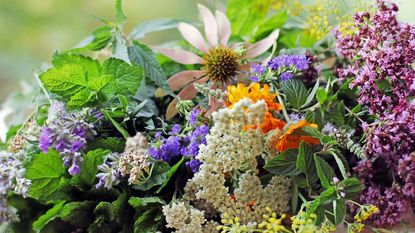Top 11 Herbs To Grow For Flower Arranging


Catherine Duncan lives in Peebles in the Scottish Borders where she grows seasonal, scented cut flowers in her garden to sell for local customers and for weddings. She is a member of Flowers from the Farm, a network of British flower growers. When not gardening she enjoys baking, cake decorating and spending time with her husband and 3 young daughters. Catherine keeps a record of her progress in the cutting garden on her blog at cloudberryflowers.wordpress.com and you can also find her on Twitter @cberryflowers and Instagram.
Mint is scented, provides texture and grows easily. However it can be prone to wilting, prevented by conditioning it well. Cutting in the evening or early morning and giving it a good drink of water for a few hours or overnight before arranging helps. There are so many varieties of mint to choose from. I have used apple mint and spearmint in the past and this year I am trying chocolate, orange and lemon mint. This is a herb that can spread rapidly throughout the garden so I grow them in pots to help contain them.
Lemon balm has a lovely fragrance and It features in my jam jar posies of flowers throughout the growing season. Again it is fairly fragile and needs conditioning well.
Rosemary is a herb that is very useful for smaller arrangements and I use it in buttonholes for weddings. It provides scent, texture and a strong background for the more delicate flowers at the front of a buttonhole. I have grown 'Miss Jessops Upright' which I have found likes a sheltered spot, keeping it away from the frequent winds we are exposed to in Scotland. You can see it below alongside some achillea in the buttonholes I made for a wedding.
Marjoram looks lovely in a bouquet of flowers. My patch of marjoram has supplied me with many long stems to use with other flowers at the end of the summer.
Lavender is well known for its uses in soaps, essential oils and cooking. It also adds scent and texture to bouquets, jam jar posies and buttonholes. I also dry it along with other flowers in the garden to make confetti for weddings. Lavender can be hard to grow in the wrong type of soil. I tried some last year in two different locations. Those I planted in the clay wet soil did not survive but the lavender in the beds with drier soil thrived.
Achillea is a very valuable herb for flower arrangements. It comes in a variety of colours and quickly forms large clumps. These can then be divided in future years to produce more plants. It has long strong stems compared to some of the more fragile herbs. I use it in bouquets with a variety of flowers including salvia, sweet peas, cosmos and scabious. You can see a bouquet below with some lovely pink achillea in it.
Gardening tips, videos, info and more delivered right to your inbox!
Sign up for the Gardening Know How newsletter today and receive a free download of our most popular eBook "How to Grow Delicious Tomatoes."
Dill adds a lightness to arrangements and can be a good filler later in the season. I combine it in arrangements with rudbeckia and dahlias. Bronze fennel provides feathery soft foliage which can be used in arrangements. It does need conditioned well overnight in water to prevent wilting. It also produces yellow flower heads at the end of the summer which make a good filler. Myrtle is a fragrant evergreen shrub which can be good for cutting. I am trying to establish these in my garden. They have struggled, perhaps because of the cold Scottish weather as they are not particularly frost hardy. If you live in a warmer climate you may have more success. Nepta catmint is a shrub loved by cats to roll around in and it is also very good in flower arrangements with its purple flowers. It is easy to grow from seed and grows quickly in the garden coming back every year. You can see it on the right of the bridal bouquet below along with marjoram and spearmint. Borage is a herb that works well in flower arrangements with its bright blue flowers on tall stems. This year I am also trying white borage.
The list of herbs you can use in flower arranging is extensive. There are always new varieties to try and in my cut flower patch this year I am growing feverfew, thyme and basil as well as those that worked well previously. It is worth experimenting yourself with different herbs. Grow the ones you like the look and scent of, as well as those you use for cooking. Then see what other flowers in your garden go well with them. Now you will have created a whole new fresh natural look to your flower arranging. Save Save Save Save Save Save Save Save Save Save Save Save Save Save Save Save

Catherine Duncan is a guest writer for Gardening Know How. She lives in Scotland where she runs a cut flower garden. She is a member of Flowers from the Farm, a network of British flower growers.
-
 How To Grow Garden To Table: A Guide For Home Cooks
How To Grow Garden To Table: A Guide For Home CooksWhat could be better than a meal that comes directly from garden to table? Show off your gardening and culinary skills with the very freshest food.
By Bonnie L. Grant
-
 Want a Backyard Mini Orchard? Create Your Own Container Orchard
Want a Backyard Mini Orchard? Create Your Own Container OrchardEasier to care for in small spaces, a backyard mini-orchard makes sense for busy gardeners and juicy fruit is the reward.
By Teo Spengler